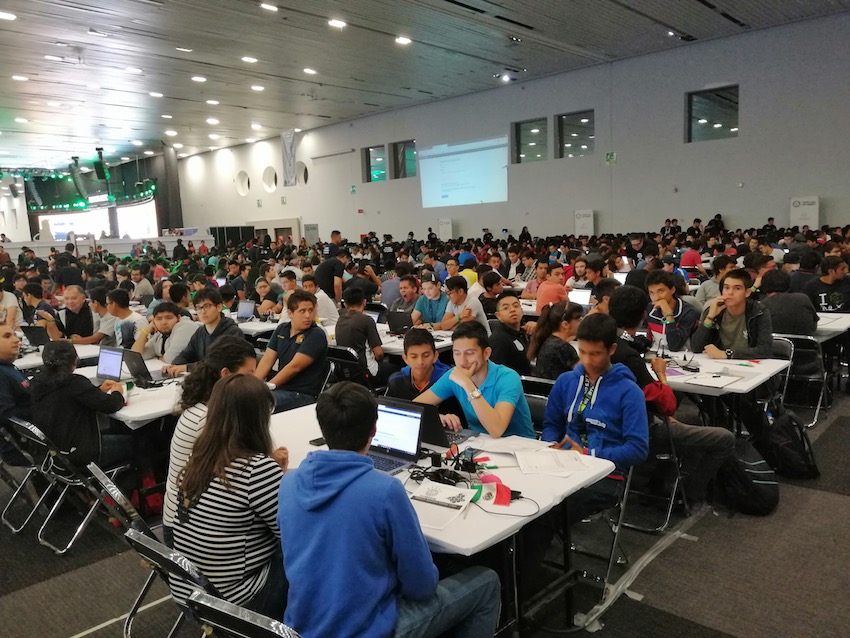AI
What We Learned Breaking a Guinness World Record
May 8, 2019 | Written by: Eduardo Gutierrez
Categorized: AI
Share this post:

Students participating in IBM’s AI Software Development Class in Guadalajara, Mexico, April 2019.
Setting a world record takes skill and effort. Breaking a world record takes something more. But that’s what we did several weeks ago in Guadalajara, Mexico.
In mid-April, and according to the Guinness Book of World Records, our group at IBM Guadalajara conducted the world’s largest AI software development class ever held, with 775 participants – shattering the previous record of 586 set in Spain in 2018.
IBM Guadalajara, is recognized for its innovation and its innovative initiatives designed to encourage new talent to work on the technological development of the country. In addition, the organization is often credited as being the pioneer in building what we currently refer to as, “the Mexican Silicon Valley.” For this AI software development project, the government of Jalisco, Mexico, joined with us to try and set the new record, with educational purposes at the core.
For 45 minutes, 775 young participants – who had no previous knowledge of programming — were trained on how to use the artificial intelligence (AI) of Watson Assistant on IBM Cloud to create a chatbot that could help hungry clients place an order for an old-time Mexican favorite dish: tacos.
Throughout this largest software class ever held, the attendees were not only excited to be breaking a world record, but were thrilled, as well, to see how the AI they were building was actually “learning,” thanks to the coding they were implementing.
They never thought that creating a practical application for AI would be that easy, until they actually started witnessing some of their very own class companions yelling in surprise things like, “It is actually taking my order!” and “It’s just as if I were talking to a real guy!”
Taking the whole class step by step throughout the entire session and making use of the user-friendly IBM Watson Assistant platform, the attendees created artificial intelligence that was able to take an order regardless of the many different ways in which we like to have our tacos here in Mexico.
Sometimes we want to have some hot sauce poured on top, sometimes we want some onion on it, or maybe we want to go wild and a double-tortilla taco. The possibilities are as diverse as we want them to be. And yet, the chatbot would understand customers and respond to them in a natural and friendly fashion.
Most of the time we tend to think that artificial intelligence is not reachable for everyone and that we need in-depth knowledge to even begin to grasp how it actually works. This world record did not only set a new boundary, but it also proved that AI is actually for everyone. The young attendants did not only learn how to create a chatbot that can take meal orders, but they learned that they can make an easy use AI to solve problems in their daily lives and use technology to be creative without having to be the most tech savvy people out there.
By the end of the class, one of the students said: “Instead of making a traditional science project in my school, I think I will create a chatbot that helps us in learning the periodic table.”
This sentiment sums up the general feeling of the class, as it showed how the potential of AI can stimulate tremendous curiosity and inspiration in young people.
As Mexicans we are getting to know the potential that AI holds to innovate and benefit our society. For instance, last year we witnessed the launching of the LUZI app, which helps pregnant women living in rural areas to monitor their babies and their vital signs, and send an alert to the nearest hospital when needed, becoming incredible helpful for this future moms as they do not have access to immediate medical care. This app, which uses IBM’s AI, is saving lives and is helping reduce maternity and infant mortality.
AI is also used for historical and educational purposes, as the National Museum of Anthropology has improved the experience of visitors by encouraging their interaction with the museum’s extensive collection of pre-hispanic art. Through a mobile application that uses AI to answer over 22 thousand questions from visitors in relation to 11 iconic pieces of the museum. Like these, there are a lot of projects that use AI from Mexican minds that are changing industries and businesses in the way we know them.
AI is provoking innovation and this worldwide record helped us demystify AI and its usage, while also sparking the spirit of inquiry in technology, AI and machine learning within young adults. New generations will need to acquire new skills to have a successful career path, as more companies will require of creative people that are able to use technology to drive innovation within a digital economy.

General Manager, IBM Mexico
Making the workplace safe for employees living with HIV
The recent promising news about Covid-19 vaccines is in sharp contrast to the absence of a vaccine for HIV, despite decades of research. Unlike Covid-19 with a single viral isolate that shows minimal diversity, HIV circulates in a wide range of strains that so far have proven impervious to a single vaccine. Fortunately, more people […]
Call for Code for Racial Justice Needs You: Join the Movement
IBM has never avoided taking on big challenges. At IBM, we are privileged to drive impact at scale. We take on challenges that transform our clients, impact people’s lives and innovate for future generations as we strive to effect systematic societal change. Over the course of our 109-year history, the evidence has become clear that […]
A New Wave: Transforming Our Understanding of Ocean Health
Humans have been plying the seas throughout history. But it wasn’t until the late 19th century that we began to truly study the ocean itself. An expedition in 1872 to 1876, by the Challenger, a converted Royal Navy gunship, traveled nearly 70,000 nautical miles and catalogued over 4,000 previously unknown species, building the foundations for modern […]


